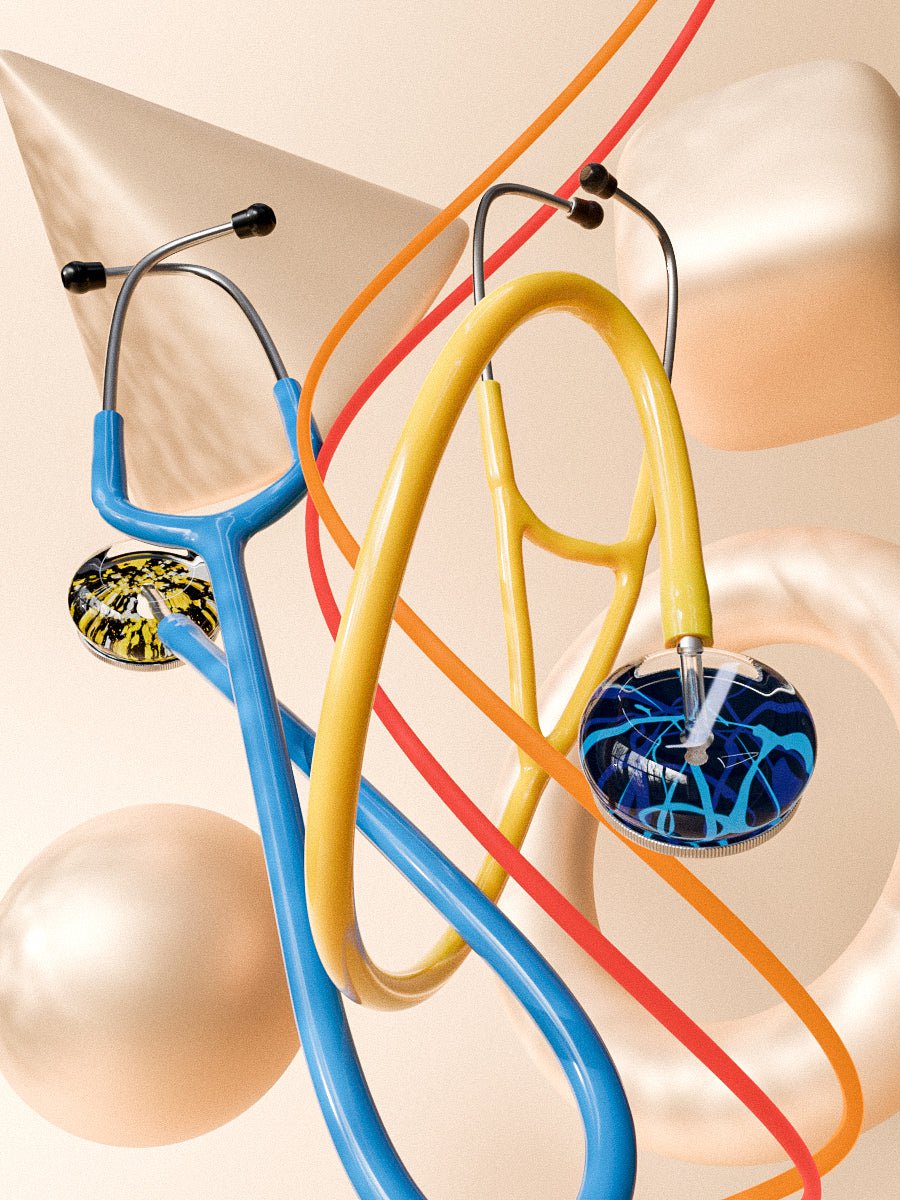Do you know the difference between pediatric and adult stethoscopes? Pediatricians are often in need of a particular type of stethoscope that has smaller chest pieces for better hearing. Adult doctors don't use these as much because they have to be more careful about blood pressure and other issues that are common in adults. A good stethoscope isn't cheap so it's a good idea to personalize your stethoscope so everyone knows that it's yours. We have some great ideas for adding bling and making your scope unique!
So what's the difference between them, anyway? This blog post from Ultrascopewill go over some of the differences and why they matter!
What are the parts to a pediatric stethoscope?
- chest piece: the part that goes over your chest and is pressed to listen for sounds in you or a child's body
- ear pieces: on an adult stethoscope, these are typically at the side of the head; pediatric ones have them closer together so they can better hear children's heartbeats.
- tubing: the tube that connects to a bell or flat diaphragm and carries sound vibrations through it.
- ear tips: different too! The ones on an adult stethoscope are typically round with a hole in them, but those for children have more of a cone shape (no holes!)
- diaphragm: the bell or flat disc that vibrates when sound passes through it and makes noise, which is amplified by the tubing so you can hear it. Pediatric stethoscopes have smaller ones because they need to be able to fit on their tiny chests!
What are the parts to an adult sized stethoscope?
- tubing: the tube that connects to a bell or flat diaphragm and carries sound vibrations through it.
- ear tips: The ones on an adult stethoscope are typically round with a hole in them.
-diaphragm: The bell or flat disc that vibrates when sound passes through it and makes noise, which is amplified by the tubing so you can hear it.
-chest piece: This part of a stethoscope sits against your patient's chest and transmits heartbeats to the diaphragm in order for you to listen to them.
What are the different types of tubes on a stethoscope?
-single lumen tubing: It has one round bore and carries sound vibrations through it.
-double lumen tubing: This type of tube has two round bores, which allow the sounds to travel in different directions at once. One side picks up higher frequencies while the other picks up lower ones.
What are some things that might cause a pediatric stethoscope to be needed?
-sounds that are not audible with an adult sized diaphragm
-smaller chest pieces for children and infants. These may have different shaped bells or membranes on the chest piece in order to amplify their heartbeats, breaths, and other sounds more effectively.
What are the most common reasons pediatricians use stethoscopes?
-to listen to bowel sounds, blood pressure changes in arteries, or fetal heart tones.
What is the price difference between pediatric and adult stethoscopes?
-pediatric stethoscopes, on average, cost more than adult ones.
What are some benefits of a pediatric stethoscope over an adult one?
-may be able to receive higher frequencies with better accuracy and clarity
-can be used for small children as well as adults
-heavier weight may make them easier to use
Pediatric and adult stethoscopes are not the same. The different shapes of bells, membranes, chest pieces, and diaphragms all come into play when determining which one is best for you! Some pediatrician's may have a pediatric stethoscope as it is more appropriate for their needs.
What are the differences between these two types of stethoscopes? Pediatric ones will be better suited to hear higher frequencies, and can be used by both adults and children alike. They're also heavier in weight, which some people say makes them easier to use. Plus, they may be able to reach patients who are lying down on a bed or in an examination chair more easily.
However, pediatric stethoscopes aren't necessarily better than their adult counterparts. It really depends on your needs and personal preference!
For adults: the bell is larger for listening at lower frequencies; the stethoscope is lighter in weight and easier to handle while listening for a long period of time; the diaphragm may be more sensitive, which some people say makes it better at hearing heart sounds.
Pediatric stethoscopes also provide better sound quality at frequencies higher than 200 Hz, so if you're looking for a high-quality instrument to pick up the finer details of your heart and lung sounds, go with a pediatric one!
Overall: while there may be certain features that one type of stethoscope has over the other, it really depends on what you need.
What You Need:
- a pediatric or adult stethoscope? It all depends! Pediatrics is better for hearing high frequencies and adults are lighter in weight; but overall this decision will depend on your needs and personal preferences.





